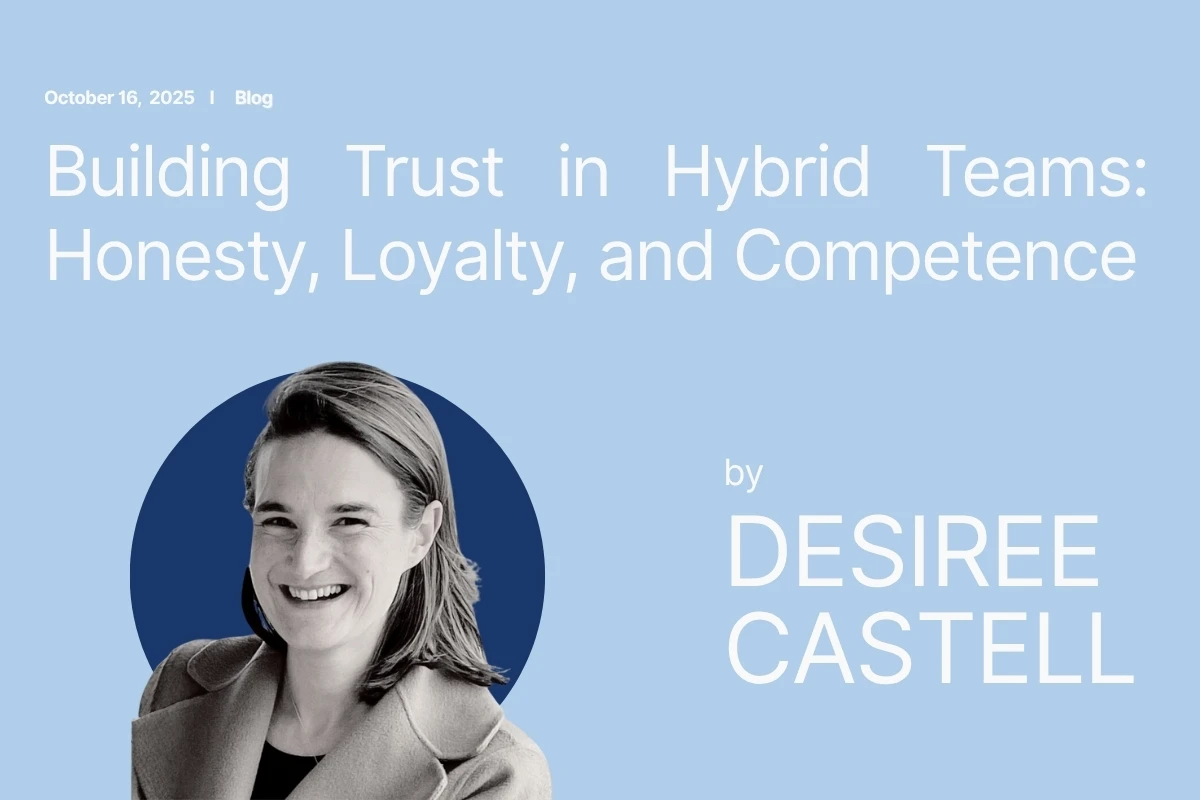Building Trust in Hybrid Teams: Honesty, Loyalty, and Competence
Key Points at a Glance
Trust is the glue that holds any team together, and it’s even more crucial in hybrid teams. When colleagues are scattered across cities or time zones, trust isn’t a “nice to have” – it’s make-or-break for effective collaboration. Classic research by Mayer, Davis, and Schoorman (1995) presents an Integrative Model of Organizational Trust, identifying integrity, benevolence and ability as the core attributes that drive trust
In our experience at Viessmann Generations Group, we’ve found that trust in a hybrid work culture can be distilled into three similar pillars: honesty, loyalty, and competence. In other words, a team member is trusted when they consistently tell the truth and act transparently (honesty/integrity), demonstrate care and support for others (loyalty/benevolence), and show capability and reliability in their work (competence/ability). Below, I dive into why building trust is more important than ever for hybrid teams.
Why Trust Matters More Than Ever in Hybrid Teams
Hybrid work has amplified the importance of trust. When we aren’t all in one office, we lose the casual check-ins and “management by walking around” that used to reassure everyone that things are on track. Leaders have limited visibility into day-to-day work, and team members can sometimes feel isolated. In this environment, trust and a sense of togetherness become imperative for supporting innovation and creativity – without them, people retreat into silos and stop sharing ideas. A recent McKinsey analysis put it plainly: “Trust and togetherness are imperative to support employee innovation and creativity” in hybrid teams (mckinsey.com)
It’s telling that Google’s famed Project Aristotle study found psychological safety – essentially a culture of mutual trust and respect – was the key factor of high-performing teams (library.hbs.edu). In fact, researchers noted that whether teammates sit in the same office or are distributed around the world mattered far less than whether they felt safe to take risks and speak up. The flip side is also true: when trust is missing, fear and micromanagement creep in, collaboration stalls, and performance suffers.
Building genuine trust is hard work – it develops slowly and steadily – but it’s absolutely worth the effort for any hybrid team. The following are the practices I’ve found most effective for cultivating each of the three pillars of trust (honesty, loyalty, and competence) in a hybrid setting.

Honesty: Create Transparency and Open Communication
Honesty is the first pillar of trust – the perception that a person adheres to sound principles and tells the truth. In a hybrid team, leading with honesty means proactively sharing information and context to bridge the gaps left by physical distance. You can’t rely on hallway conversations or osmosis for information-sharing when much of the team is remote. As leaders and teammates, we have to deliberately pull back the curtain:
- Over-communicate context and decisions: Be transparent about the “why” behind choices and changes. For example, I provide regular updates (via messages or virtual meetings) on what’s happening across the team and the organization and the reasoning behind major decisions. This consistent context-setting prevents people from feeling “in the dark” and enables them to make better decisions.
- Admit what you don’t know: If you’re asked a question and don’t have the answer, say so honestly – “I don’t have that information right now, but I will find out” – rather than bluffing. Admitting uncertainty or mistakes actually builds credibility; it shows integrity and encourages others to speak up when they have concerns or make errors. I strive to model this vulnerability by openly acknowledging my own missteps or areas where I’m still learning.
- Ensure clarity in roles and expectations: Miscommunication can easily breed distrust, especially in a hybrid environment where we don’t have as many casual touchpoints. To counter this, make sure everyone knows their responsibilities and how success will be measured. Document decisions and action items openly (for instance, in shared documents or team chat channels) so that there’s a single source of truth. In our team, we plan our quarterly Objectives and Key Results (OKRs) in one shared Google Sheet.
Honesty and transparency might sometimes be uncomfortable (e.g. sharing bad news or admitting faults), but in the long run they pay off in trust.

Loyalty: Foster Empathy, Support, and “Togetherness”
Loyalty in a team context means having each other’s backs. In other words, do we genuinely care about each other’s well-being and success, aside from just our own gain? Demonstrating benevolence or goodwill builds a deep reservoir of trust, because people feel safe and supported. Here are some ways we intentionally cultivate togetherness and show loyalty on a hybrid team:
- Create personal connection rituals: Since we don’t bump into each other in hallways, we schedule small rituals to connect on a human level. For example, our team has a light-hearted virtual chat every Monday morning to kick off the week. Once a month, a different team member leads fun icebreakers or games to spark laughter and curiosity. These moments of levity strengthen bonds and remind us that we’re more than just faces on a screen.
- Express appreciation frequently: A short “Friday Thank You” – whether a quick call or a chat message – goes a long way. I make it a habit (and encourage others) to call out a colleague’s effort or help at the end of the week: “Thank you for jumping in to fix that issue” or “Appreciate how you handled that project hurdle.”
- Prioritize in-person meetups: We prioritize gathering in person as a team and company every quarter. During these get togethers, we don’t only talk shop – we share meals, do fun activities, and have unstructured time to chat about life. These real experiences and conversations forge a stronger personal attachment. In a hybrid setting, the feeling of “we’re in this together” is priceless – it turns physical distance into a minor detail because emotionally the team is tight-knit.
By actively cultivating empathy and togetherness, you fulfill the loyalty aspect of trust and make colleagues want to be vulnerable with each other, knowing they’ll be supported.

Competence: Deliver Consistently and Empower Accountability
The third pillar of trust is competence – doing your job well and reliably. In Mayer et al.’s model this corresponds to ability, the set of skills and competencies that enable a person to have influence or perform in a specific domain. Nothing erodes trust in a team faster than a pattern of missed deadlines or low-quality work. Especially in hybrid teams, where we can’t physically see each other’s work in progress, we rely on outcomes to tell us whether someone is competent and dependable. If those outcomes are consistently good, trust grows. If they’re inconsistent or poor, trust plummets – colleagues start to doubt if they can count on you. Some fundamentals we emphasize include:
- Do what you say you will do: This is the simplest trust-builder. If you promise to send a report by Thursday, make sure it’s sent by Thursday. Hitting your commitments shows your teammates they can rely on your word. And if something truly prevents you from delivering, communicate early and renegotiate the deadline – don’t drop the ball quietly. In a hybrid context, where each person’s workflow is somewhat invisible to others, these professional courtesies are amplified in importance. Consistency creates predictability, and predictability creates trust..
- Establish transparent workflows and accountability: To keep everyone confident in each other’s progress, it helps to have shared routines and tools. For example, our project teams hold a brief weekly OKR check-in meeting and updates task status in a shared project tracker (we use Asana) visible to all. These habits ensure that progress (or blockers) are apparent even if no one is in the same office. It also distributes responsibility – everyone knows they are expected to update the group, which fosters a sense of ownership. When every member consistently pulls their weight and updates the team, people start to relax any anxieties and trust the group’s competence as a whole. They know: “Everyone here is committed and pulling their weight; I won’t be left carrying the bag alone.”
Focusing on competence doesn’t mean expecting perfection; it means instilling a sense of responsibility in each team member. In a high-competence culture, people hold themselves accountable because they don’t want to let the team down. Reliability becomes the norm.


Conclusion: Trust as the Cornerstone of Hybrid Success
Building trust in hybrid teams is an ongoing journey – one that requires effort and consistency. When honesty, loyalty, and competence become embedded in how we work, trust follows. And with trust comes a team that communicates openly, supports one another, and performs at its peak even across distances. I’ll be the first to admit I’m still learning every day how to build and sustain trust better. Trust-building is a leadership practice you never truly finish – it requires attention, honest self-reflection, and adaptation as your team evolves. But it’s absolutely worth it. If you invest in cultivating honesty (integrity), loyalty (benevolence), and competence (ability) within your hybrid team, you’ll create a resilient, high-performing group that can weather challenges and seize opportunities, no matter where everyone is sitting.
Sources:
- Mayer, R.C., Davis, J.H., & Schoorman, F.D. (1995). An Integrative Model of Organizational Trust, Academy of Management Review, 20(3), 709–734 – Defining trust as willingness to be vulnerable and identifying ability, benevolence, and integrity as key trust factors, makinggood.ac.nz
- Scharf, S. & Weerda, K. (2022). How to lead in a hybrid environment, McKinsey & Company – Emphasizing that trust and togetherness are imperative for innovation and creativity in hybrid work, mckinsey.com
- Edmondson, A. & Baskin, K. (2023). Four Steps to Building the Psychological Safety That High-Performing Teams Need, HBS Working Knowledge – Noting Google’s Project Aristotle found psychological safety (a climate of trust) to be a key component of successful teams, library.hbs.edu
Our Product Specsheet
Key Points at a Glance
Trust is the glue that holds any team together, and it’s even more crucial in hybrid teams. When colleagues are scattered across cities or time zones, trust isn’t a “nice to have” – it’s make-or-break for effective collaboration. Classic research by Mayer, Davis, and Schoorman (1995) presents an Integrative Model of Organizational Trust, identifying integrity, benevolence and ability as the core attributes that drive trust
In our experience at Viessmann Generations Group, we’ve found that trust in a hybrid work culture can be distilled into three similar pillars: honesty, loyalty, and competence. In other words, a team member is trusted when they consistently tell the truth and act transparently (honesty/integrity), demonstrate care and support for others (loyalty/benevolence), and show capability and reliability in their work (competence/ability). Below, I dive into why building trust is more important than ever for hybrid teams.
Why Trust Matters More Than Ever in Hybrid Teams
Hybrid work has amplified the importance of trust. When we aren’t all in one office, we lose the casual check-ins and “management by walking around” that used to reassure everyone that things are on track. Leaders have limited visibility into day-to-day work, and team members can sometimes feel isolated. In this environment, trust and a sense of togetherness become imperative for supporting innovation and creativity – without them, people retreat into silos and stop sharing ideas. A recent McKinsey analysis put it plainly: “Trust and togetherness are imperative to support employee innovation and creativity” in hybrid teams (mckinsey.com)
It’s telling that Google’s famed Project Aristotle study found psychological safety – essentially a culture of mutual trust and respect – was the key factor of high-performing teams (library.hbs.edu). In fact, researchers noted that whether teammates sit in the same office or are distributed around the world mattered far less than whether they felt safe to take risks and speak up. The flip side is also true: when trust is missing, fear and micromanagement creep in, collaboration stalls, and performance suffers.
Building genuine trust is hard work – it develops slowly and steadily – but it’s absolutely worth the effort for any hybrid team. The following are the practices I’ve found most effective for cultivating each of the three pillars of trust (honesty, loyalty, and competence) in a hybrid setting.

Honesty: Create Transparency and Open Communication
Honesty is the first pillar of trust – the perception that a person adheres to sound principles and tells the truth. In a hybrid team, leading with honesty means proactively sharing information and context to bridge the gaps left by physical distance. You can’t rely on hallway conversations or osmosis for information-sharing when much of the team is remote. As leaders and teammates, we have to deliberately pull back the curtain:
- Over-communicate context and decisions: Be transparent about the “why” behind choices and changes. For example, I provide regular updates (via messages or virtual meetings) on what’s happening across the team and the organization and the reasoning behind major decisions. This consistent context-setting prevents people from feeling “in the dark” and enables them to make better decisions.
- Admit what you don’t know: If you’re asked a question and don’t have the answer, say so honestly – “I don’t have that information right now, but I will find out” – rather than bluffing. Admitting uncertainty or mistakes actually builds credibility; it shows integrity and encourages others to speak up when they have concerns or make errors. I strive to model this vulnerability by openly acknowledging my own missteps or areas where I’m still learning.
- Ensure clarity in roles and expectations: Miscommunication can easily breed distrust, especially in a hybrid environment where we don’t have as many casual touchpoints. To counter this, make sure everyone knows their responsibilities and how success will be measured. Document decisions and action items openly (for instance, in shared documents or team chat channels) so that there’s a single source of truth. In our team, we plan our quarterly Objectives and Key Results (OKRs) in one shared Google Sheet.
Honesty and transparency might sometimes be uncomfortable (e.g. sharing bad news or admitting faults), but in the long run they pay off in trust.

Loyalty: Foster Empathy, Support, and “Togetherness”
Loyalty in a team context means having each other’s backs. In other words, do we genuinely care about each other’s well-being and success, aside from just our own gain? Demonstrating benevolence or goodwill builds a deep reservoir of trust, because people feel safe and supported. Here are some ways we intentionally cultivate togetherness and show loyalty on a hybrid team:
- Create personal connection rituals: Since we don’t bump into each other in hallways, we schedule small rituals to connect on a human level. For example, our team has a light-hearted virtual chat every Monday morning to kick off the week. Once a month, a different team member leads fun icebreakers or games to spark laughter and curiosity. These moments of levity strengthen bonds and remind us that we’re more than just faces on a screen.
- Express appreciation frequently: A short “Friday Thank You” – whether a quick call or a chat message – goes a long way. I make it a habit (and encourage others) to call out a colleague’s effort or help at the end of the week: “Thank you for jumping in to fix that issue” or “Appreciate how you handled that project hurdle.”
- Prioritize in-person meetups: We prioritize gathering in person as a team and company every quarter. During these get togethers, we don’t only talk shop – we share meals, do fun activities, and have unstructured time to chat about life. These real experiences and conversations forge a stronger personal attachment. In a hybrid setting, the feeling of “we’re in this together” is priceless – it turns physical distance into a minor detail because emotionally the team is tight-knit.
By actively cultivating empathy and togetherness, you fulfill the loyalty aspect of trust and make colleagues want to be vulnerable with each other, knowing they’ll be supported.

Competence: Deliver Consistently and Empower Accountability
The third pillar of trust is competence – doing your job well and reliably. In Mayer et al.’s model this corresponds to ability, the set of skills and competencies that enable a person to have influence or perform in a specific domain. Nothing erodes trust in a team faster than a pattern of missed deadlines or low-quality work. Especially in hybrid teams, where we can’t physically see each other’s work in progress, we rely on outcomes to tell us whether someone is competent and dependable. If those outcomes are consistently good, trust grows. If they’re inconsistent or poor, trust plummets – colleagues start to doubt if they can count on you. Some fundamentals we emphasize include:
- Do what you say you will do: This is the simplest trust-builder. If you promise to send a report by Thursday, make sure it’s sent by Thursday. Hitting your commitments shows your teammates they can rely on your word. And if something truly prevents you from delivering, communicate early and renegotiate the deadline – don’t drop the ball quietly. In a hybrid context, where each person’s workflow is somewhat invisible to others, these professional courtesies are amplified in importance. Consistency creates predictability, and predictability creates trust..
- Establish transparent workflows and accountability: To keep everyone confident in each other’s progress, it helps to have shared routines and tools. For example, our project teams hold a brief weekly OKR check-in meeting and updates task status in a shared project tracker (we use Asana) visible to all. These habits ensure that progress (or blockers) are apparent even if no one is in the same office. It also distributes responsibility – everyone knows they are expected to update the group, which fosters a sense of ownership. When every member consistently pulls their weight and updates the team, people start to relax any anxieties and trust the group’s competence as a whole. They know: “Everyone here is committed and pulling their weight; I won’t be left carrying the bag alone.”
Focusing on competence doesn’t mean expecting perfection; it means instilling a sense of responsibility in each team member. In a high-competence culture, people hold themselves accountable because they don’t want to let the team down. Reliability becomes the norm.


Conclusion: Trust as the Cornerstone of Hybrid Success
Building trust in hybrid teams is an ongoing journey – one that requires effort and consistency. When honesty, loyalty, and competence become embedded in how we work, trust follows. And with trust comes a team that communicates openly, supports one another, and performs at its peak even across distances. I’ll be the first to admit I’m still learning every day how to build and sustain trust better. Trust-building is a leadership practice you never truly finish – it requires attention, honest self-reflection, and adaptation as your team evolves. But it’s absolutely worth it. If you invest in cultivating honesty (integrity), loyalty (benevolence), and competence (ability) within your hybrid team, you’ll create a resilient, high-performing group that can weather challenges and seize opportunities, no matter where everyone is sitting.
Sources:
- Mayer, R.C., Davis, J.H., & Schoorman, F.D. (1995). An Integrative Model of Organizational Trust, Academy of Management Review, 20(3), 709–734 – Defining trust as willingness to be vulnerable and identifying ability, benevolence, and integrity as key trust factors, makinggood.ac.nz
- Scharf, S. & Weerda, K. (2022). How to lead in a hybrid environment, McKinsey & Company – Emphasizing that trust and togetherness are imperative for innovation and creativity in hybrid work, mckinsey.com
- Edmondson, A. & Baskin, K. (2023). Four Steps to Building the Psychological Safety That High-Performing Teams Need, HBS Working Knowledge – Noting Google’s Project Aristotle found psychological safety (a climate of trust) to be a key component of successful teams, library.hbs.edu
.jpg)

.svg)

.svg)
.svg)

.svg)
.svg)
.svg)






